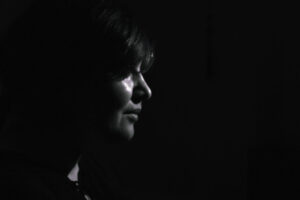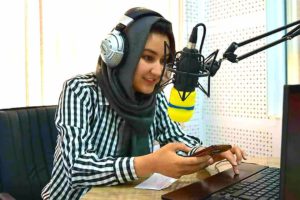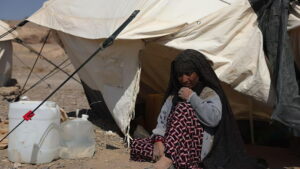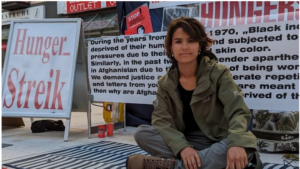Shira Badakhshi
I remember being between 7–8 years old. We had a tiny black-and-white TV. One day, a show about the life of a Palestinian cartoonist named Naji al-Ali was shown on TV. Every scene of his life seemed to overlap with mine, which impressed me greatly. His drawings showed a sad and stateless child. A few days later, I remember drawing pictures of people with cat-like faces on the school desks. My sketchbook was always completed before my notebooks. I used to draw on the wall of the house, in the room, on the door, on the floor, and anywhere else that could be scratched.

My father was originally from Badakhshan, Afghanistan, and my mother belonged to the Iranian Kurdish Peshmerga. My mother’s family was murdered by the Iranian government, but she was able to escape to Afghanistan. She married my father when she was 14 years old, and I and my six siblings were born there. I was born in 1985. Because my family was poor, I was given to an Afghan family for some money and forced to marry at the age of 15. I was unable to convince them to let me study. I have two children: a boy and a girl.

Nevertheless, in 2008, I began working as a journalist and cartoonist for a magazine called Negin in Kunduz. The paper advocated for the rights of Afghan women. I was able to publish reports on financial corruption and sexual assaults in the Kunduz municipality, as well as on female prisoners there. Later, I got questioned and threatened by the Kunduz Municipality not to continue my work. The building of the journal was set on fire by unknown people, and the financial support we received from the German International Cooperation Agency (GIZ) was cut off.
Before the complete Taliban takeover of Afghanistan, we fled from Kunduz to the Iranian border due to the numerous clashes and attacks perpetrated by the Taliban in the city of Kunduz. We arrived in Iran to seek refuge in Turkey and then in a European country. Unfortunately, we were repeatedly arrested by the Turkish police while trying to illegally enter Turkey, and then we ran out of money. We were forced to stay in Iran. The laws of Iran are very strict and discriminatory towards immigrants. We can’t legally work or buy a house.

I went to the High Commissioner for Refugees (UNHCR) in Tehran many times, but they asked us to just call and gave us a phone number that never existed. We do difficult and limited tasks like cleaning the streets and homes of Iranians. Furthermore, it is offered to us at the lowest possible wages and compensation.
In Afghanistan, we were required to wear the burka. Only in Kabul, we had the privilege of refraining from wearing it. Because it looked like a sack, I disliked this type of dressing. Only your eyes were visible through the fishnet opening. You could only see through the holes in front of your feet. The view is so narrow that you can easily fall into a hole or pit. The surrounding image looks as if you are looking through prison bars.

Like most women and girls, I loved braiding my hair and throwing it around. However, for us, it resembled a fairy tale.
The protests in Iran began after a young girl was killed because her hair was visible. A new decision has been made by the Iranian Intelligence Ministry, stating that Afghan women with visible hair will be immediately deported to Afghanistan and will have no right to protest.
After years of being away from cartoons, getting to know the Kite Runner media hub made me pick up a pencil and draw again. For me, who has been introverted and distant since childhood, drawing has been a healing experience. To draw, you must have a dream in your mind that is different and beautiful. The art of drawing and painting is a form of energy that is transferred from the hand to the pen. In my opinion, a cartoon means fighting against all injustices and oppression against girls, women, and children. I believe that active participation is the best solution for societies development. Cartoons are used to criticize injustice. Pictures can help you express things that no one else would.


